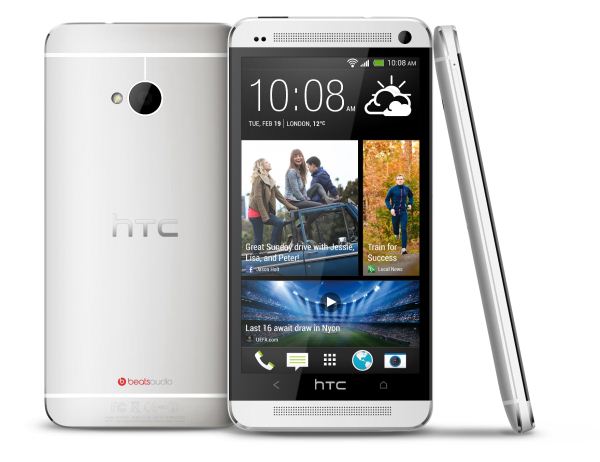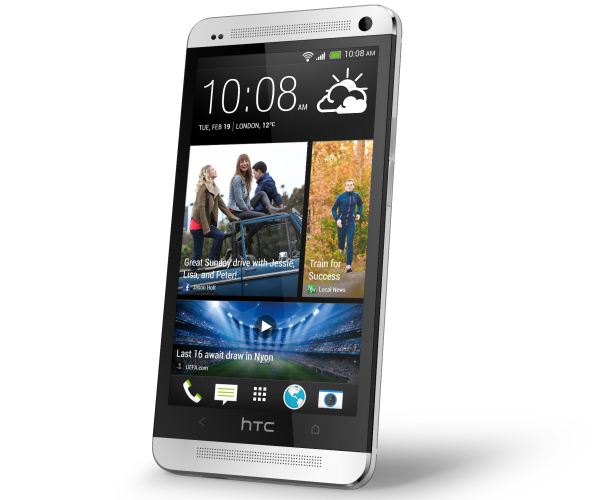Hands on and Impressions from the HTC One - Formerly M7
by Brian Klug on February 19, 2013 10:30 AM EST- Posted in
- Smartphones
- HTC
- Mobile
- HTC One
- Snapdragon 600
HTC is in an interesting position as a result of this last product cycle. While the previous HTC One series’ industrial design and performance was top notch, other OEMs still managed to eclipse the One series in terms of market adoption and consumer perception. Getting back to being a solid performer and cementing a place as at least the dominant number three player in the smartphone space is HTC’s mission for 2013, and the flagship device it’s starting that out with is the device previously known as M7, now known simply as the HTC One.
Design and Construction
The choice of the HTC One name really emphasizes how much this launch means to HTC — this is the canonical One. This is the fullest expression of HTC’s view for what the One lineup should mean, this is their flagship. The One is a clear evolution of the industrial design first begun with the Butterfly and DNA, except instead of plastic the One is machined from a single solid block of aluminum. There are over 200 minutes of CNC machine cuts per device, which is a unibody construction. Plastic is injected into the aluminum block after certain cuts are made for the back case, which then gets machined into the final form. The One uses the top and bottom aluminum strips for antennas, both of which are actively tuned to mitigate unintended attenuation from being held. There’s a plastic insulative strip in-between the two antennas and the main body. In spite of being aluminum, the One also includes NFC, whose active area surrounds the camera region. There’s no wireless charging from Qi or WPC, however.
In the hands the HTC One has the kind of fit and finish that I’d expect from a high end device. I thought that the One S was perhaps the best industrial design of 2012 in part thanks to the metal backside, unique concave shape, and size. The truth is that the HTC One feels even better than that. There’s something inescapable about metal — HTC described it as expensive and luxurious feeling, like a well crafted tool. Other OEMs with metal phones like to evoke imagery of watches or high end jewelry. I think at some fundamental level metal does imply value, and as a result it conveys a much higher end in-hand feel than other entirely polycarbonate plastic designs. There’s a thin strip of plastic which runs around the edge of the device, and it’s here that the microSIM tray, ejection port, primary microphone, microUSB port, power/lock button (which doubles as IR transmit and receive), earphone jack, and volume rocker sit. The front has two aluminum pieces which serve as the speaker, microphone, and earpiece grilles. The HTC One will come in both an uncolored silver version, and anodized black.
The One is topped with a 4.7-inch 1080p Super LCD 3 display. We’ve said that 2013 is going to be the year of 5-inch phones, and 4.7 is just shy. I think there’s something almost optimal about the device size that results with a 16:9 display size just short of 5-inches diagonal. It’s still possible to one hand if you have medium sized hands, easy to pocket, and still not laughably huge.
The HTC One at first glance might seem reminescent of another big metal unibody device, but in the hand couldn’t feel any more different. The convex rounded back side gives the One an entirely different in-hand feel, and the edges have a slight negative angle to them in addition to two chamfers.
Rather than place the primary speaker on the backside of the One, HTC has placed a set of speakers on the front of the device, one at top, one at bottom, behind the two grilles. These two provide stereo sound, and placing them on the front instead of the bottom or back makes a lot of sense for things like watching video, Google Navigation, and listening to music. The One also has dual microphones for noise rejection on calls, and also two different microphone pairs for accommodating low volume and high volume environments when recording audio. For example the commodity microphones generally included in a smartphone saturate around 70 dBA, HTC claims the dual microphone system on the One can accommodate up to 120 dBA SPL (Sound Pressure Level) without saturating.


















139 Comments
View All Comments
nerd1 - Tuesday, February 19, 2013 - link
720p in 4.7" is already 312PPI, and no one with 2.0/2.0 eyesight will see pixels from 10" distance.I just don't understand why this silly 'PPI' race is going on.
They put 4MP sensor and says they won't do the megapixel race - then why do the PPI race which is plain meaningless? At least high-MP camera is better for outdoor pics. 400+ppi screen is good for nothing.
repoman27 - Tuesday, February 19, 2013 - link
Are you old enough to remember when consumer oriented printers began focusing on dots per inch? 144 DPI clearly sucked, the early laser printers at 300 DPI were a godsend but expensive, and once prices came down and competition from inkjets heated up the race was on to 600, 1200 or more DPI. Today we take it for granted, but when was the last time you printed a document at less than 600 DPI?Unlike printers, LCDs don't need to handle halftone screens and can take advantage of anti-aliasing. However, I spend quite a bit of time reading very small text on my phone. I'll be happy when virtually all of the LCDs in my life are closer to 600 PPI. Also consider the sizable Asian market and the impact that resolution makes on non-latin script at small sizes.
Whining about real progress on a tech site is ridiculous, especially with all the pointless arguments about what viewing distance person x or person y can still discern a pixel at. If text is easier to read at higher resolutions for a good percentage of the population, then there is still a reason to go there. If you compare text and photos printed at 300 and 600 DPI it's obvious that most people can see a difference.
nerd1 - Tuesday, February 19, 2013 - link
DPI is different from PPI, as they need dithering to display halftones.And there is biological limit for display PPIs. You simply cannot outresolve 300PPI screen at 10 inch distance, even if your eyesight is 2.0/2.0.
repoman27 - Tuesday, February 19, 2013 - link
I already pointed out the halftone issue, which is a decidedly different technique than dithering. While you may not be able to readily distinguish individual pixels on a 300 PPI display from 10 inches, I will bet money that most people can tell the difference when looking at type on a 300 PPI display vs. a 600 PPI display.I used to do prepress work. I've looked at plenty of output at various resolutions that was strictly PostScript text or vector based graphics with no halftoning or dithering involved. 300 PPI is not enough to be indistinguishable from higher resolutions. The difference between 600 and 1200 requires a loupe for me.
Mind you I never said that 1920x1080 was a good choice of resolution for a phone. I'm happier with slightly smaller displays and different aspect ratios, but then again I almost never watch movies or play games on my phone.
The yield argument is ridiculous. The yields will always be negligible if nobody specs the damn things. I'm also not in the market for a cheaper phone. I want a better phone, and I'm quite willing to pay for it. Unfortunately no matter how much I seem to pay AT&T I can't manage to get anything better in the way of carrier service in my home market.
nerd1 - Tuesday, February 19, 2013 - link
And you just CANNOT increase resolution without sacrificing anything. High resolution LCDs requires more bright backlight, has lower yield and of course burdens GPU way more. (Remember current gen consoles cannot render any game in 1080p)If they use 720p panel instead, they can make the phone cheaper, more brighter (given the same backlight), and cooler (less GPU load). and most importantly last longer.
All these sacrifices for silly 1080p marketing gimmick nobody will distinguish from normal distances. Maybe in one year or two, some OEM will say that PPI race is meaningless and they will give 2x battery life instead. Ironically, HTC did the same with this phone with their camera MP count.
iamezza - Wednesday, February 20, 2013 - link
I agree, that trade-offs you make for the higher pixel count isn't worth it at this stage.Mithan - Tuesday, February 19, 2013 - link
Will this work with Android 5 when it comes out?Does anybody know?
steven75 - Tuesday, February 19, 2013 - link
If only going by the looks/materials this shames any other Android phone I've seen. Looks high end far unlike any of the popular Samsung devices.lefenzy - Tuesday, February 19, 2013 - link
frustrates me so muchmutatio - Tuesday, February 19, 2013 - link
Given that HTC has had some adjustments to their phones due to mimicking Apple, I'm surprised to see a complete lack of commentary by Klug on the obvious design elements that seem hijacked from the iPhone. The end product looks like a hybrid of the iPhone 5 (beveled chamfered edge, color scheme, antenna integration, etc.) and and iPhone 3G/S (rounded back). It looks sharp but the clear design rip-offs are obvious. Also, I'm not so sure about the whole cluster of gear along the top of the front panel. Would a center mounted camera make it too obvious of an Apple ripoff? The whole issue of eyes being slightly off focus while looking at the screen is always an issue but is best mitigated with a center mounted camera. There is always a compromise in terms of turning the device to a different orientation but it's always beneficial to have at least one of the orientations having a center mounted camera. It seems the corner position will make the user always appear to look off to the side in the image regardless of orientation. It's great to have amped up speakers, but IMHO, if the intent behind front facing cameras is to facilitate face-to-face social interaction, designs that work to distance the user from a more personal interaction should be reconsidered.